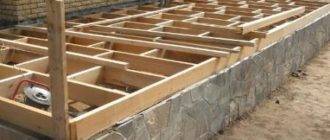It is not at all necessary that wooden steps for stairs are attached to a homogeneous material - they can also decorate a metal or concrete structure. The whole question, perhaps, is not how it will look, because natural materials are always pleasing to the visual perception, but how to fix them so that the cladding looks natural. Now we will discuss such possibilities, and also watch the video in this article, which will help to better reveal the topic.
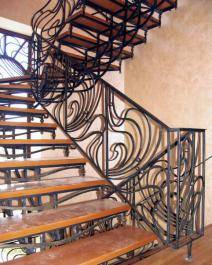
Stairs
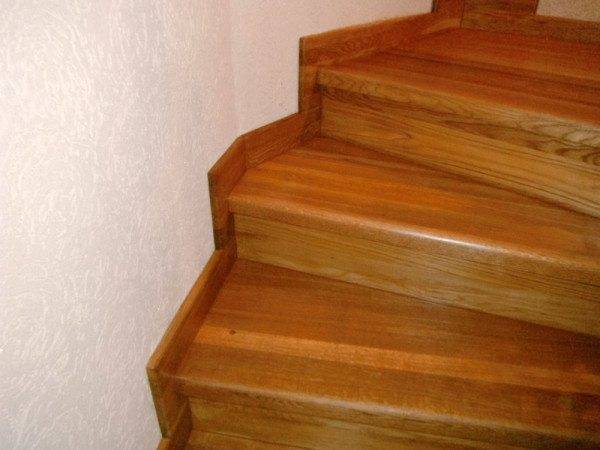
Wood has always been one of the best facing materials and is used with great success and unchanged popularity for the construction and decoration of stairs. First of all, this concerns the steps, for which there is a special instruction on their dimensions for convenient and safe movement. Therefore, before calculating a flight of stairs, you will have to think through a lot of little things regarding all the geometric parameters of the treads and risers.
Requirements for stairs
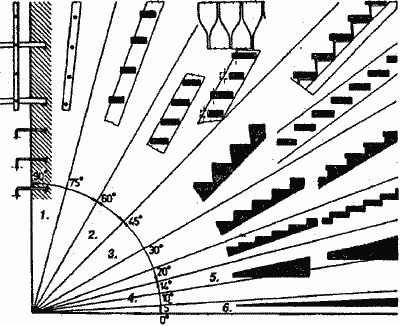
- If we are talking about wooden structures, then in 95% of cases work is meant indoors, therefore, we will pay attention to such stairs. All norms and standards for such structures are regulated in GOST 8486-86, GOST 8556-72, GOST 23120-78 and GOST 2.109, from which we will take the basic requirements regarding internal stairs for residential and non-residential premises. Subject to the standards, of course, the price of the product also often changes, but these requirements will further provide you with convenient and safe operation.
- One of the most painful places for internal structures is the angle of inclination, on which the width and height of the steps of the stairs depends, because by making the descent and ascent more gentle, we thereby increase the occupied space. In the private sector, the ascent angle sometimes reaches 50⁰, although a slope of 35⁰ is considered the most optimal. Nevertheless, metal stairs with wooden steps will be appropriate from 26 to 50, if the required dimensions of the treads and risers are observed.
Advice. Long flights of stairs, starting from a slope of 40⁰, are easily overcome only for trained people. For children and the elderly, such movements require a lot of effort, therefore, whenever possible, large stairs, especially in several flights, are best done between 30⁰ and 35⁰ of a slope.
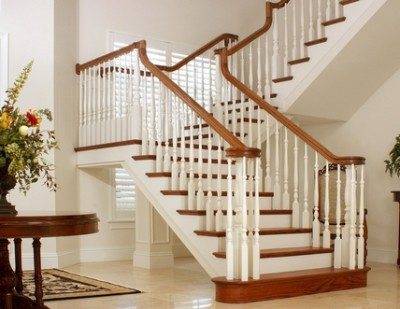
- Taking into account the requirements of GOSTs, a staircase with three or more steps must have a railing, the height of which, together with handrails, must reach at least 0.9 m (for outdoor stairs 1.2 m), but no more than 18 steps are allowed on one flight... The transitions between the spans are equipped with a platform, the width of which cannot be less than that of the stairs, and the length is not less than the average step of a person, or the transition is carried out due to turning steps. Of course, these requirements do not apply to spiral and spiral staircases, where the very concept of a march is absent.
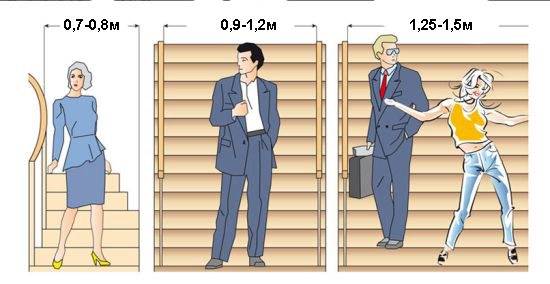
- If you take into account the rules, then according to GOST 23120-78, the minimum width of the march can be 0.7 m, therefore, stairs with a width of 0.7-0.8 m are recommended to be used for transitions with a low frequency of movement... The most demanded passage is 1.0-1.2 m and you can observe this in the entrances of residential buildings, therefore, when making a staircase at home with your own hands, you better adhere to this particular standard. And, finally, spacious spans for elite and public buildings are 1.25-1.5 m, where two obese people can easily pass each other - all these standards are due to the emergency evacuation of residents.
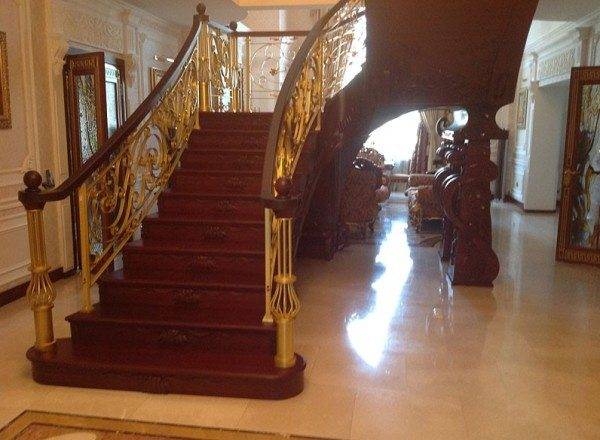
Advice.For wooden stairs and steps made of the same material, conifers are most often used, as well as ash, hornbeam, oak and even mahogany, as can be seen in the top photo. For treads and risers, spruce is sometimes used - it is whiter than pine, but it easily cracks when nails are driven into it or self-tapping screws are screwed into it, therefore, first you should drill a passage hole of a smaller diameter.
Installation of stairs and steps
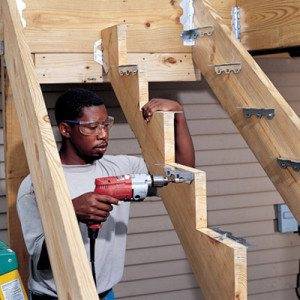
- Wooden stair steps can be mounted both on a stringer and on a bowstring, or on a structure that combines both types of such inclined beams, as shown in the photo above. But to create and equip these profiles, it is necessary to take into account the future parameters of treads and risers. The main starting point for the design of the step is the step size of the average person (160-180 cm), which is 60-64 cm or 0.6-0.64 m.
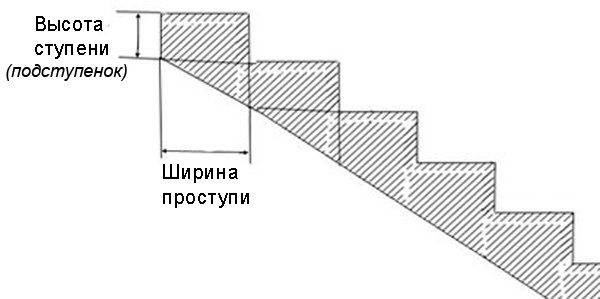
- Now let's see how to calculate wooden steps for a staircase made of any material, taking into account the average step of an adult. The width of the tread should be 25-30 cm, this will allow 70% of the foot to fit on a rigid base, which will make movement not only comfortable and safe, but also bring it in line with the fire regulations of NPB 245-97. If we add to these figures the height of the step (the height of the riser and the thickness of the tread), then in the end we should get from 60 to 64 cm.
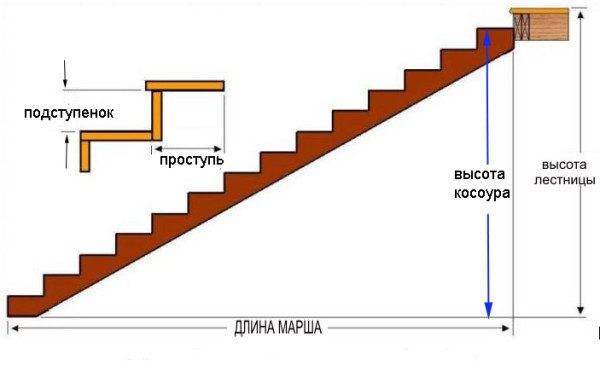
- Let's imagine that we need to install stringers and steps for wooden stairs or even one march from the first to the second floor of a cottage-type building. Since our calculations are approximate, we will take the parameters of the room so that we get fewer fractional numbers, which means that the height from the ceiling to the floor will be 2.6m, plus an overlap with a tiled floor of 0.25m - total - 2.85m.
- The floor on the second floor will also serve as a step, therefore, taking into account the floor, this height can be divided into 15 steps - 2.85 / 15 = 0.19m, which means that in total on the kosour we will have 14 treads with a distance of 0.19m in height (from surface to surface). Now, in accordance with the height and size of the average step, we need to determine the width of the tread and we can substitute the value 26 cm - 19 * 2 + 26 = 64 cm - what we need.
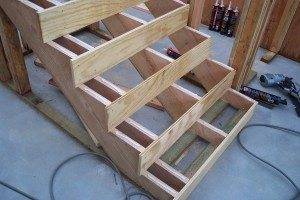
- Now you need to decide on such a parameter as the thickness of the step of a wooden staircase (tread and / or riser), which should be at least 2500 mm. Here everything will depend on the width of the span and the number of bowstrings and stringers on the march - the smaller the distance from one fulcrum to another, the thinner the tread can be. The riser does not bear a special load, so its thickness can remain in the economy mode - 0.25-0.3 m.
- Now, if we get a ladder with a width of 1.0 m, then the tread can be 1000x260x40 mm, although the last parameter (thickness) can be changed at your discretion. The riser with the given tread dimensions will give us 1000x150x25 mm. Do not forget that a step width of 1000 mm does not mean that the working width of the span is identical, since at least 50 mm will go for mounting balusters on the railing.
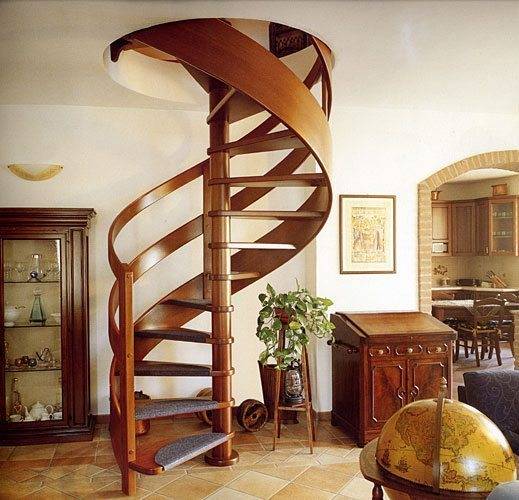
- In situations where the tread width is less than 25 cm (a large slope or the arrangement of turning steps on a U- or L-shaped staircase), run-in steps are used. On straight marches, the tread hangs over the riser by 30-40 mm, but not more than 50 mm, but for turning steps, everything is somewhat more complicated. The narrow part of the tread in the pivot structure should be at least 100 mm (excluding the distance under the overhanging visor) to ensure a safe positioning of the toe on the ascent or the heel on the descent.
- Since we are talking about the dimensions of the steps, then it would not hurt us to calculate the length of the stringer or bowstring for a given structure, and for this we can apply the formula A2+ B2= C2, where A is the height of the stringer, B is the length of the march, and C is the required length of the stringer. Hence, A2+ B2=(2,85-0,19)2+(14*0,26)2= 7.0756 + 13.2496 = 20.32.52, but this is the value of C2... Then √20.32.52 = 4.508m - this will be the net length of the stringer, and the workpiece will need 15-20 cm more.
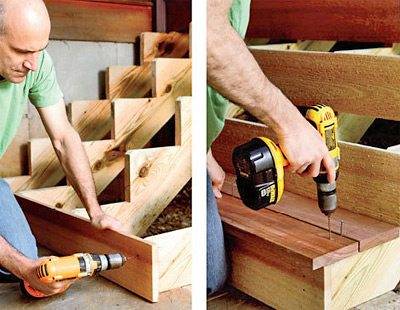
- Another question is how to fix the steps on a wooden staircase, and here you will need a screwdriver and wood screws. In the top photo you can see how risers and treads are attached to the stringer.
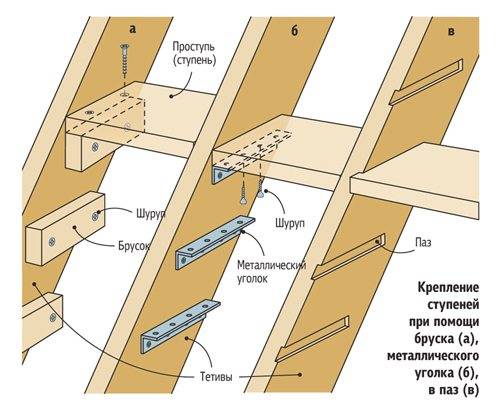
- The upper figure shows the options for attaching the treads to the bowstring: a) using a wooden bar; b) with a metal corner and c) with a groove. The first two options are the most popular, since it takes more time to mark and sample the groove.
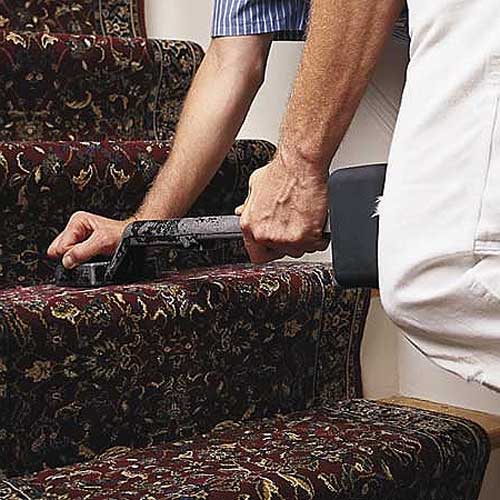
- Some are interested in how to cover the steps of a wooden staircase, although wood itself is an excellent facing material and by and large there is enough varnish, sometimes in combination with stain. But if the steps have already lost their appearance, then carpet or laminate can be used for covering, and both are fixed with glue.
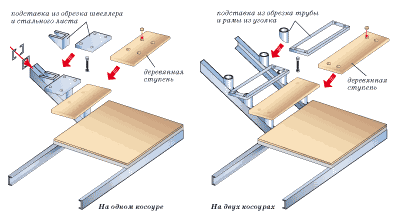
Conclusion
Metal structures are also sheathed with wood, so iron stairs with wooden steps are not at all uncommon. But for the installation of treads in such cases, a steel corner should be used, which will serve as a support frame. Most often, risers are not used at all for such an arrangement, especially if everything is attached to the central stringer.
Happy construction!


